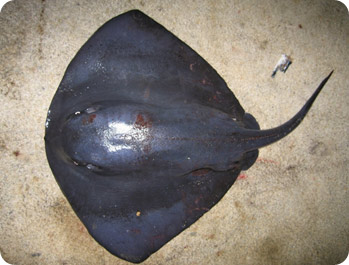When Steve Irwin died from the jab of a stingray last year, it made headlines around the world. TV’s “Crocodile Hunter” died after the venomous barb punctured his heart.
 Despite the hoopla, stingrays don’t attack people that often. They’re usually pretty shy. They hang out in the sand on the ocean floor, feeding on clams and other bottom dwellers. They use their stingers only for defense.
Despite the hoopla, stingrays don’t attack people that often. They’re usually pretty shy. They hang out in the sand on the ocean floor, feeding on clams and other bottom dwellers. They use their stingers only for defense.
There are dozens of species of stingrays. They’re found in most oceans and seas, usually in fairly shallow tropical waters. The smallest are just a few inches across, while the biggest can weigh several hundred pounds.
Like all rays, they’re related to sharks. Instead of bones, they have rubbery cartilage. They have wide, thin bodies and long, skinny tails. They use their wing-like dorsal fins to “fly” through the water.
A stingray attacks with a barb near the base of its tail. The barb often has a serrated edge, like a bread knife. The barb injects a venom that contains enzymes that destroy tissue, and a neurotransmitter that causes muscles to violently contract.
Most attacks on humans occur when somebody steps on the ray. Painful hits on the legs and feet require treatment, but they’re almost never fatal. Most deaths -- which are quite rare -- occur when the barb punctures the heart or abdomen.
So the best defense against a stingray is to protect your legs and ankles, slide your feet in shallow waters to scare stingrays away -- and if you see one, give it plenty of room.
Copyright 2007. The University of Texas Marine Science Institute

